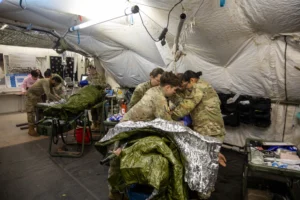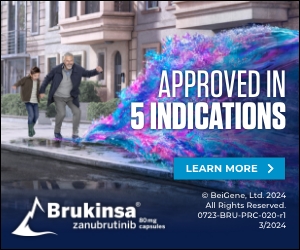
U.S. Army Soldiers, assigned to Landstuhl Regional Medical Center, participate in tactical medical training at Landstuhl, Germany, on Nov. 14, 2024. The training focused on enhancing battlefield medical skills to provide lifesaving care in combat environments. (DoD Photo by Travis Jones)
Bethesda, MD — Prophylaxis for venous thromboembolism (VTE) is crucial in people who have had traumatic brain injuries (TBIs), due to their heightened risk caused by immobility, inflammation and coagulation system activation. Yet there is ongoing concern that the use of anticoagulants such as low-molecular-weight heparin (LMWH) or unfractionated heparin (UFH) might worsen posttraumatic intracranial hemorrhage (ICH) or cause new bleeding in the brain, particularly when administered too early after the injury.
A recent literature review concluded that initiating chemoprophylaxis 72 hours after a traumatic brain injury (TBI) is safe; however, insufficient evidence remains to support its use earlier than this.
Since firm guidelines on the timing of chemoprophylaxis after traumatic brain injury (TBI) are lacking—and with research showing that one-third of venous thromboembolism (VTE) episodes occur within the first three days post-injury—researchers sought to address this critical gap. Investigators from the Military Traumatic Brain Injury Initiative, Walter Reed National Military Medical Center and Henry M. Jackson Foundation for the Advancement of Military Medicine conducted a comprehensive search of English-language literature. They reviewed multiple databases and consulted all available registries to identify relevant studies, aiming to better understand the balance between early anticoagulation and the risk of hemorrhagic complications in TBI patients.1
Studies were included in the analysis, if they provided information on the timing of VTE chemoprophylaxis initiation (e.g., within 24, 48 or 72 hours after TBI), comparisons between early versus late or treated versus untreated cases, the type of pharmacological prophylaxis used or data on head CT-documented intracranial hemorrhage (ICH) progression following chemoprophylaxis initiation in treated and untreated groups.
The researchers analyzed 30 studies that met the inclusion criteria, evaluating the percentage risk of ICH progression based on the earliest treated group regardless of timing or the treated group for those studies in which timing of treatment was not reported. Additionally, they stratified the percentage risk of ICH progression in the earliest treated group based on specific treatment intervals: within 24 hours, within 48 hours and within 72 hours.
Overall, the risk of post-traumatic intracranial hemorrhage (ICH) progression documented by head CT after VTE chemoprophylaxis was 7.0%—significantly lower than rates reported in studies examining the natural course of posttraumatic ICH progression, they reported in the Journal of Neurology. The researchers attributed the higher rates in those studies to the inclusion of patients with a higher baseline risk of ICH progression.
The analysis found low rates of intracranial hemorrhage (ICH) progression associated with VTE chemoprophylaxis, regardless of timing (<24 hours: 12%, <48 hours: 15%, <72 hours: 7%). The meta-analysis found no evidence that VTE chemoprophylaxis increased the odds of CT-documented ICH progression after TBI. In fact, earlier prophylaxis showed slightly lower odds of progression. Stratification by timing revealed that only the <48-hour group showed higher odds of progression, while the <24-hour and <72-hour groups were less likely to experience progression compared to their later counterparts. However, the authors said it was important to emphasize that only a small number of lower-quality studies addressed the 48-hour or 24-hour time point.
Although the researchers’ primary goal was to study the incidence of traumatic ICH progression relative to the presence and timing of VTE chemoprophylaxis, they performed a second data extraction from all 30 selected publications about the incidence of VTE and related complications. “We found that the risks of VTE, DVT and PE were 5.3%, 2.2% and 0.7%, respectively,” the authors wrote, citing research which show that despite mechanical and pharmacological prophylaxis, VTE occurs in every fifth patient with TBI.
“The results of this meta-analysis demonstrate that, despite 20 years of published effort, the optimal timing of VTE chemoprophylaxis after TBI still remains enigmatic,” the researchers noted. This knowledge gap has significant medical and socioeconomic implications, as studies indicate a rising incidence of VTE in TBI patients, which is associated with poorer outcomes. These include extended hospital stays, increased medical costs, and higher rates of procedures like tracheostomy and gastrostomy.
The findings emphasize the urgent need for robust evidence to guide clinical decisions regarding VTE chemoprophylaxis in the acute TBI setting, the researchers concluded. “A randomized noninferiority trial should be the next step in answering the question of early (within 72 hours) VTE chemoprophylaxis after TBI.”
- Dengler BA, Haight T, Fu A, Hafeez SJ, Cirivello M, Bartanusz V. Safety of early chemoprophylaxis for venous thromboembolism after traumatic brain injury: a systematic review and meta-analysis. A military traumatic brain injury initiative study. J Neurosurg. 2024 Nov 22:1-12. doi: 10.3171/2024.7.JNS232697. Epub ahead of print. PMID: 39576983.

